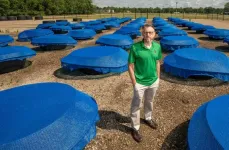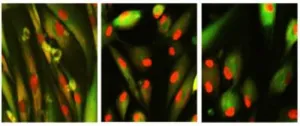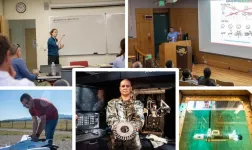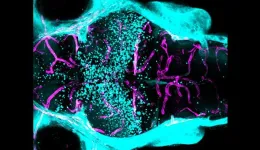A novel biosensor for detecting neurogenerative disease proteins
Researchers at EPFL introduce the highly-multidisciplinary, AI-enhanced, biosensing tool ImmunoSEIRA for the detection of misfolded proteins linked to Parkinson’s and Alzheimer’s disease.
2023-07-12
(Press-News.org)
By combining multiple advanced technologies into a single system, EPFL researchers have made a significant step forward in diagnosing neurodegenerative diseases (NDDs) such as Parkinson's disease (PD) and Alzheimer's disease (AD). This novel device is known as the ImmunoSEIRA sensor, a biosensing technology that enables the detection and identification of misfolded protein biomarkers associated with NDDs. The research, published today in Science Advances, also harnesses the power of artificial intelligence (AI) by employing neural networks to quantify disease stages and progression. This significant technological advance holds promise not only for early detection and monitoring of NDDs, but also for assessing treatment options at various stages of the disease’s progression.
Treatment of neurodegenerative diseases faces a significant challenge due to the lack of effective diagnostic methods for early detection and monitoring of disease progression. Protein misfolding, a common mechanism in neurodegeneration, has been identified as a key event in disease progression. It is hypothesized that healthy proteins misfold first into oligomers in early stages and into fibrils in later stages of the disease. These misfolded protein aggregates circulate in the brain and biofluids and also accumulate as deposits in the brains of deceased NDD sufferers. But the development of tools to detect these tell-tale signs of disease—known as biomarkers—has remained elusive until now. The hurdles to accurate detection are multiple, including limits of current technology to accurately separate and quantify different protein aggregates.
Combing multiple advanced technologies into one sensor
To create this advanced NDD biomarker sensor, researchers at Professor Hatice Altug’s Bionanophotonic Systems Laboratory (BIOS) and Professor Hilal Lashuel’s Laboratory of Molecular Neurobiology and Neuroproteomics (LMNN) have combined multiple fields of science: protein biochemistry, optofluidics, nanotechnology, and artificial intelligence (AI). "Unlike current biochemical approaches which rely on measuring the levels of these molecules, our approach is focused on detecting their abnormal structures. This technology also allows us to differentiate the levels of the two main abnormal forms implicated in the development and progression of NDDs, oligomers and fibrils,” says Lashuel
The ImmunoSEIRA sensor employs a technology called surface-enhanced infrared absorption (SEIRA) spectroscopy. This method allows scientists to detect and analyze the forms of specific disease-associated molecules, known as biomarkers, associated with neurodegenerative diseases. The sensor is equipped with a unique immunoassay, which acts like a molecular detective, identifying and capturing these biomarkers with high precision.
"In our paper, we present a technological solution that integrates nanoplasmonics, cleanroom nanofabrication, microfluidics, immunoassay, AI, and advanced biochemical methods," says PhD student and main author of the paper Deepthy Kavungal. "Our ImmunoSEIRA sensor exhibits structural sensitivity and the capability to monitor a panel of complementary biomarkers with high specificity from small sample volumes in complex biomatrices."
Joining the power of nanotechnology and artificial intelligence
The ImmunoSEIRA sensor features gold nanorod arrays with antibodies for specific protein detection. It enables real-time specific capture and structural analysis of target biomarkers from extremely small samples. Neural networks, a subset of AI algorithms, are then employed to identify the presence of specific misfolded protein forms, the oligomeric and fibrillary aggregates, achieving an unprecedented level of detection accuracy as the diseases progress. Lashuel believes that this is a significant advance in disease detection, adding that, “since the disease process is tightly associated with changes in protein structure, we believe that structural biomarkers, especially when integrated with other biochemical and neurodegeneration biomarkers, could pave the way for more precise diagnosis and monitoring of disease progression.”
The EPFL research team went a step further to show that the ImmunoSEIRA sensor can be used in real clinical settings, i.e. in biofluids. They were able to accurately identify the specific signature of abnormal fibrils, a key indicator of neurodegenerative diseases, even in complex fluids like human cerebrospinal fluid (CSF). Professor Altug explains that the next step with this new technology “is to continue to expand its capabilities and evaluate its diagnostic potential in Parkinson’s disease and the growing number of diseases caused by protein misfolding and aggregation.”
The results of this study mark a significant advancement in the fields of biosensing, infrared spectroscopy, nanophotonics, and neurodegenerative disease biomarkers. The deployment of the AI-aided ImmunoSEIRA sensor is a welcomed advance for early NDD detection, disease monitoring, and drug efficacy assessment, addressing the critical need for timely intervention and treatment of neurodegenerative diseases.
END
[Attachments] See images for this press release:
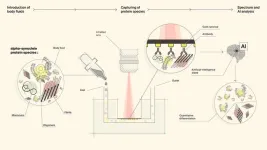
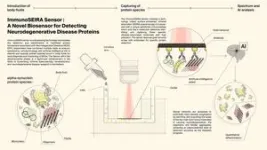
ELSE PRESS RELEASES FROM THIS DATE:
2023-07-12
Schistosomiasis, a parasitic disease that causes organ damage and death, affected more than 250 million people worldwide in 2021, according to the World Health Organization.
One of the world’s most burdensome neglected tropical diseases, schistosomiasis occurs when worms are transmitted from freshwater snails to humans. The snails thrive in water with plants and algae that proliferate in areas of agricultural runoff containing fertilizer. People become infected during routine activities in infested water.
Researchers from the University of Notre Dame, in a study recently published in Nature, found that removing invasive vegetation at water access points in and around several ...
2023-07-12
Since the International Organisation of Vine and Wine (OIV) approved the use of ultrasound to promote the extraction of grape compounds back in 2019, its application for obtaining superior red wines has been studied extensively.
Now researchers are turning their attention to rosé – an expanding market which has seen strong growth over the past 15 years. A team from the University of Castilla-La Mancha and the University of Murcia in Spain used high-power ultrasound technology to treat Monastrell crushed grapes – a process known as sonication ...
2023-07-12
On July 12, 2023, a new research paper was published in Aging, titled, “Chemically induced reprogramming to reverse cellular aging.”
BUFFALO, NY- July 12, 2023 – In a groundbreaking study, researchers have unlocked a new frontier in the fight against aging and age-related diseases. The study, conducted by a team of scientists at Harvard Medical School, has published the first chemical approach to reprogram cells to a younger state. Previously, this was only achievable using a powerful gene ...
2023-07-12
The Naval Innovation Center (NIC) at the Naval Postgraduate School (NPS) in Monterey, Calif., is part of the Secretary of the Navy’s initiative to leverage the power of American innovation for national security. Integral to the function of the NIC is the Naval Innovation Exchange (NIX), a new program that organizes and empowers multidisciplinary teams of NPS students and faculty focused on developing prototype research solutions.
While in its early stages, the NIC at NPS will leverage and empower ...
2023-07-12
At a glance:
Working with mice and zebrafish, researchers identify a gene, expressed in neurons, that produces a signal needed for development and maintenance of the blood-brain barrier.
When mutated, the gene makes certain regions of the blood-brain barrier more permeable.
The findings could help scientists control the blood-brain barrier — important for delivering drugs into the central nervous system or countering damage from neurodegenerative disease
What makes the vital layer of protective cells around the brain and spinal cord — ...
2023-07-12
Psychedelic-based therapies are poised to change the treatments that psychiatrists can offer patients.
“I often talk about psychedelic treatments as catalysts for change, for both the individual and the field of psychiatry,” said Medical University of South Carolina psychiatrist Jennifer Jones, M.D., who conducts research on these treatments.
The highly anticipated approval of MDMA, or “ecstasy,” to treat post-traumatic stress disorder would be the first for a psychedelic drug, ushering in changes for patients, mental health providers and society. The Food and Drug Administration is expected to issue a decision on MDMA-assisted ...
2023-07-12
Cancer therapies that target specific genetic abnormalities in tumors have revolutionized treatment possibilities over the past two decades. While quality of life and survival are improved with targeted therapies, relapse is common due to the evolution of new tumor cells that are resistant to the targeted therapy. A new study by investigators from the Mass General Cancer Center, a member of the Mass General Brigham healthcare system, reveals how lung tumors may develop drug resistance over time, pointing to a protein, called APOBEC3A, that could be a promising target. Results, published in Nature, may help researchers develop new ...
2023-07-12
NEW YORK, NY-- A new study suggests that eye drops developed by Columbia University researchers could be a more effective–and comfortable–therapy for a common eye disease currently treated with injections into the eye.
Retinal vein occlusion (RVO), an eye disease that affects up to 2% of people over age 40, occurs when a vein in the eye’s retina becomes blocked, leading to swelling in the eye, inflammation, damage to the retina, and vision loss.
Standard therapy involves injecting into the eye a vascular endothelial growth factor inhibitor (anti-VEGF) that reduces swelling. ...
2023-07-12
Scientists at the University of Texas Institute for Geophysics (UTIG) have developed a radar technique that lets them image hidden features within the upper few feet of ice sheets. The researchers behind the technique said that it can be used to investigate melting glaciers on Earth as well as detect potentially habitable environments on Jupiter’s moon Europa.
The near-surface layers of ice sheets are difficult to study with airborne or satellite ice-penetrating radar because much of what’s scientifically important happens too close to the surface to be accurately imaged. ...
2023-07-12
New Haven, Conn. — Simply the smell of seafood can make those with an allergy to it violently ill — and therefore more likely to avoid it. The same avoidance behavior is exhibited by people who develop food poisoning after eating a certain meal.
Scientists have long known that the immune system played a key role in our reactions to allergens and pathogens in the environment, but it was unclear whether it played any role in prompting these types of behaviors towards allergic triggers.
According to Yale-led research published July ...
LAST 30 PRESS RELEASES:
[Press-News.org] A novel biosensor for detecting neurogenerative disease proteins
Researchers at EPFL introduce the highly-multidisciplinary, AI-enhanced, biosensing tool ImmunoSEIRA for the detection of misfolded proteins linked to Parkinson’s and Alzheimer’s disease.


